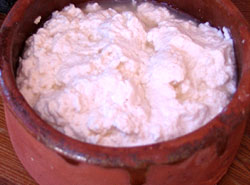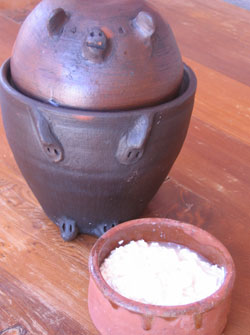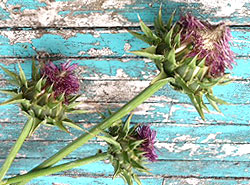MORE CHEESES
Photos and recipes of new cheeses created by me and contributing hobbyists will rotate through on a regular basis.
Making Cheese in Clay Vessels Using Natural Plant Coagulants
|
Because this method of cheese making is ancient and simple, I have chosen to leave the instructions in a narrative format. You can use raw or pasteurized cow or goat milk.
I hope you’ll try making cheese this way at least once to experience the process. As noted in the recipe, the cheese is best if consumed 3 days-1 week from the time it is made.
Natural plant coagulants are those which are used in their natural state to coagulate milk; cardoon and other thistle stamen, nettles, and yarrow are easiest to grow and
harvest from your garden. Cardoon thistle stamens can also be purchased online from www.tagines.com.
If you have fig trees nearby, fig tree bark can also be used. To use the nettles and yarrow first crush the plant matter to release the useful extract before adding it to
the milk. These natural coagulants are first infused into heated milk, and then strained out before making the cheese. Use only a small amount; only as much as is needed to
coagulate the milk. Too much of any of the natural coagulants can result in bitter tasting curds.
Perfect for cheese making or any type of clay pot cooking, a large assortment of clay vessels is available at Bram clay pot cookware in Sonoma, or online
at www.bramcookware.com.
Use the simple cheese making method listed below, substituting one of these natural coagulants for the rennet. Start by using a large pinch of the thistle stamens;
or a small chunk of bark or yarrow; or a few leaves of the nettle. Add the coagulant to the milk, bring the milk to temperature, and let steep for 30 minutes. Strain out
the bits of plant and continue on to make the cheese as directed.
If after a few hours after straining the milk you do not see coagulation, add a small amount of diluted rennet to cause coagulation. Heat milk to 86 degrees F,
and then stir in 3 drops rennet diluted in water. Then follow the rest of the directions below. The infusion of the thistle stamen will have given some tart earthiness to
the curds, and therefore to the cheese.
Click here for recipe
|
   Photos: Mary Karlin |
Sweet Curd Cheese using Vegetable Rennet
Using a 3-4 quart La Chamba or other clay pot.
1/2 gallon Raw or Pasteurized Whole Milk, left at room temperature for 2 hours
Vegetable Rennet or Natural Coagulant (as noted)
1 1/2 teaspoons kosher salt
Warm your clay pot slightly by filling with hot water 20 minutes before making the cheese. Dump out the water before filling with the milk.
Using a simmer mat or other heat-defusing burner plate under the clay pot, slowly heat the milk to 86 degrees F. Add 6 drops vegetable rennet diluted in 2 tablespoons non-chlorinated water,
stir in with a whisk, cover, and then turn off the heat. Leave the pot covered to keep the milk warm, and allow the milk to ripen for 1-2 hours or until the curds are set.
Depending upon the temperature in the room and the amount of residual heat in the pot, it could take a few more hours for the curds to set. Once set, cut the curds into 1/2 inch size pieces, drain
in cheesecloth for 5 minutes, toss the curds with 1 1/2 teaspoons of salt, continue to drain until whey stops dripping, then move the curds into a glazed clay crock. Cover, and store in refrigeration
for 3-5 days.
For a firmer cheese, move the drained curds in their cheesecloth to a small shaping basket, lightly press for 1 hour, turn, dry-salt the exterior, return to the basket, place on a drying rack and
allow to air-dry for 6-8 hours (turning over once) or until the surface is dry to the touch. Then move the cheese to the glazed clay crock, cover and refrigerate. Consume within 1 week.
Copyright Mary Karlin 2009 | Author photos: Sweet Curd Cheese in crock; Thistle Curd (Bram); Thistle Cheese aged 3 days; Thistle curd made in La Chamba
Close.
Blue Jack-style Cheese
Jack cheese is an American original; one that everyone loves. It’s moist, creamy, and very versatile. Currently there are a few Jack-style cheeses showing up from notable cheese makers with just a
bit of blue in the crevices. That small amount of tangy blue mold in contrast with the creamy paste makes for a subtle, but delicious, lightly flavored blue. To make my version, some p. rouqeforti
mold is added between layers of curds before pressing in a cheese mold. As an alternative, the cheese can be pressed in the cheesecloth sack as the Jack Cheese recipe (page 96-97) directs. By
pressing with only 5 pounds of weight, desirable small crevices are left in the pressed curds for the blue mold to develop. No piercing occurs.
Makes one 2-pound cheese or two 1-pound cheeses
Click here for recipe
|
 |
Milk: Pasteurized whole cow’s milk
Start to Finish:
Making the cheese: 2.5 hours + 12 hours pressing + 24 hours drying
Aging: 2 months or longer
Equipment & Supplies:
Non-reactive 10- quart stock pot
Instant-read or dairy thermometer
Flexible wire, long handle stainless steel whisk
Measuring spoons
2 small dishes for diluting calcium chloride and rennet
Food- grade flexible blade rubber spatula
Curd-cutting knife or 10 inch cake decorating spatula
Glass measuring cup
Mesh skimmer or ladle
Metal bowl or plastic bucket
Mesh strainer or colander
Butter muslin
Half-size baking sheet with draining rack
8-inch Tomme mold (or two 5-inch Tomme molds) with follower
Gallon jug filled with enough water for 5# weight
Ripening box with mat and lid
Ingredients:
- 2 gallons pasteurized whole cow’s milk
- 1/2 teaspoon MA 4001 Farmhouse starter
- 1/2 teaspoon calcium chloride diluted in 1/4 cup cool non-chlorinated water
- 1/2 teaspoon liquid rennet diluted in 1/4 cup cool non-chlorinated water
- 2 tablespoons kosher salt
- 1/8 teaspoon penicillium roqueforti mold
Steps:
- In a non-reactive stock pot, slowly heat the milk over a low flame to 86 degrees F. Sprinkle the starter over the surface and let rehydrate for 5 minutes.
Mix well using a whisk in an up and down motion. Turn off heat, cover, maintaining 86 degrees, to ripen the milk for 1 hour.
- Add the dissolved calcium chloride and stir gently with a whisk using an up-and-down motion for 1 minute.
- Add the dissolved rennet and stir gently with a whisk using an up-and-down motion for 1 minute.
- Cover and let set off heat, at 86 degrees for 30-45 minutes or until the curds give a clean break when cut with a knife. If no clean break, wait a few minutes more.
- While maintaining 86 degrees cut the curds into 3/4-inch cubes and let set for 5 minutes.
- Over low heat, bring the curds to 102 degrees, increasing the temperature slowly over a 40 minute period. Using a rubber spatula, gently stir continuously to keep curds from matting together.
The curds will be releasing whey, firming up slightly and shrinking to the size of a dried bean.
- Once the desired temperature has been reached, let the curds rest undisturbed for 30 minutes. They will sink to the bottom and the whey will rise to the top.
- Using a measuring cup, remove enough whey to expose the curds. Using the rubber spatula, gently stir continuously for 15-20 minutes or until the curds are matted and cling together when a
small sample is pressed in your hand.
- Place a colander over a bowl or bucket large enough to capture the whey. Line the colander with dampened butter muslin and ladle the curds into it. Let drain for 5 minutes then toss in 1
tablespoon of the salt with your hands and mix thoroughly.
- Draw the ends of the cloth together and twist into a ball to exude a small amount of the excess whey.
- Working quickly, open the sack on a clean work surface and place 1/3 of the warm curds into a damp cheesecloth-lined mold. Sprinkle with 1/2 of the p. roqueforti mold,
then top with a second third of the curds and lightly press using your hand. Sprinkle the last of the p. roqueforti mold over the top and cover with the last of the curds.
Press with your hands, then draw up the tails of the cloth and cover the top of the curds. Place follower on top and set on a draining rack and top with the weight.
- At room temperature, press at 5 pounds for 8 hours at 75-85 degrees, flipping once and continuing pressure in that time frame. It is important to leave some small crevices
in the pressed curds as places for the blue mold to develop.
- Remove the cheese from the mold, dry rub with the remaining 1 tablespoon of salt and place back on the draining rack to air dry. Lightly cover with dry cheesecloth and let
air-dry at room temperature for 24 hours or until the surface is dry to the touch. Turn once during the drying stage for even removal of moisture.
- Place in a ripening box to ripen at 50-55 degrees in 85 % RH for 2-6 weeks, turning the cheese daily for even ripening. Leave the lid slightly ajar for the first 3 days
to allow for the mold to begin to develop. Then close the lid for the duration of ripening; opening once daily to allow for gas exchange. Remove any excess moisture that may
collect in the box or on the cheese. Remove any unwanted mold development on the surface of the cheese. Blue mold should start to appear through the crevices in about 7-10 days.
Continue to ripen until the desired ripeness is reached. Vacuum-seal or wrap well in plastic wrap and refrigerate until ready to eat. Cheese is ready to consume at this point.
Copyright Mary Karlin 2009
Close.




